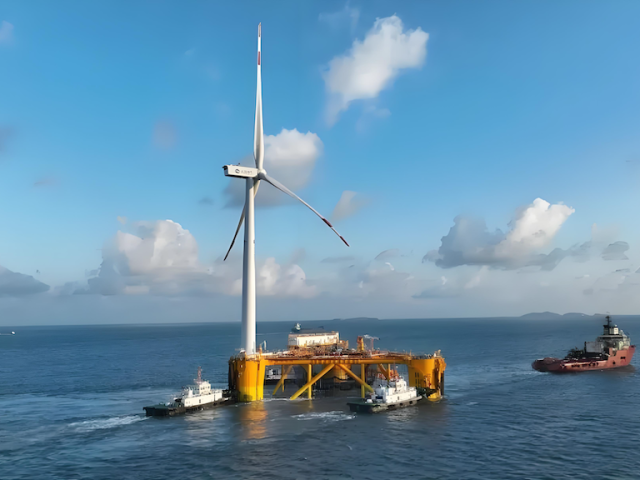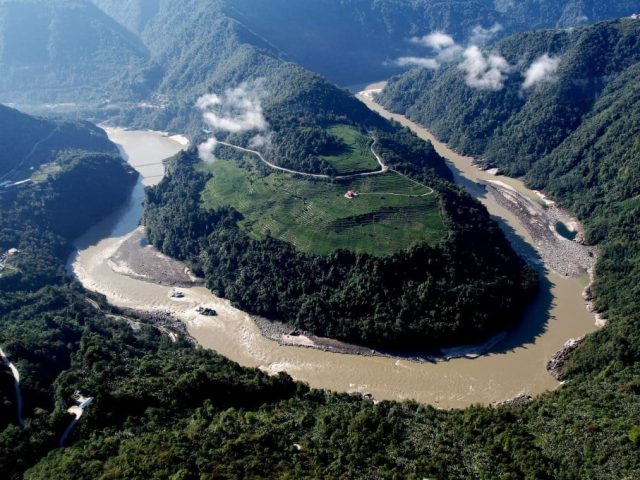The main tower of Pier 28 of the bridge is constructed by the China Railway Bridge Bureau and it is 17.6 meters long, 14 meters wide, 106.8 meters high, and weighs 2800 tonnes. The steel tower is manufactured in the plant in a horizontal position. The steel tower was then transported to the bridge location using a barge as a whole before tilting and erecting it.
The entire steel tower was tandem lifted using a 3600-tonne floating crane, crane vessel “Bridge Seagull” and 1200-tonne floating crane, tilting the tower vertically in the air.
Comparing conventional bridge towers install in sections, the steel tower of Jinhai Bridge is installed vertically in the air. The entire vertical tilting process is divided into 73 steps to ensure the operation go smoothly.
Bridge Seagull Crane Vessel
The vessel is 118.9 m (390 ft) long, 48 m (157 ft) wide, and has a draft of 4.8 m (16 ft). The built-in floating crane has four main hooks together capable of lifting 3,600 tons to 110 m (361 ft), and two auxiliary hooks together capable of lifting 600 tons to 130 m (427 ft). Both lifting capacity and hosting height rank first among domestic China vessels of the same type.
Bridge Seagull was first designed to provide a lifting solution for the erection of 80m and 88m steel truss beam of the Pingtan Strait Bridge, which requires a crane of more than 3,200 tonnes and a lifting height of 110m for a period of 24 months. In order to meet the lifting requirements, in early 2015, China Railway Bridge Bureau decided to invest 340 million yuan (53 million US dollars). Wuchang Shipbuilding Industry Group won the tender in building the crane vessel which took a total of 20 months to build, and it was commissioned on 9th Jan 2017 at their Qingdao facilities.
Construction of the bridge started in April 2018. At present, the erection of the steel box beams on the top of the four main tower piers has been completed; the continuous rigid frame beams on the Hengqin side have all been closed, and the side span steel beams have been closed.
The design of 51 side caps in Hezhou has been completed; 51 pier designs have been completed, 46 have been completed; 48 continuous rigid-frame beams have been completed; more than 80% of the full-bridge steel beam manufacturing has been completed. The bridge is expected to be completed and opened to traffic in 2023.

Jinhai Avenue Bridge
The first highway-railway structure in the Pearl River estuary, the Jinhai Avenue Bridge is 11.2 km (7 miles) long from the Jingwan Tunnel on southern Hengqin Island to the Sanzao Tunnel beneath East Airport Road (S727) in Jinwan District. The designated speed is 100 km/h (62 mph) for the dual six-lane highway and 160 km/h (99.5 mph) for the centre double-track railway.
The bridge comprises east and west approach bridges, a main structure across the Modaomen Waterway, and Hezhou Island, Baiteng River, and Sanzao sections. It will form part of the Airport Urban Rail Transit Phase II and cut travel time between Jinwan and Hengqin to 10-15 minutes. Motorists will be able to reach Zhuhai (Jinwan) Airport from Gongbei in 25 minutes.
Integrated into the Zhuhai Airport Urban Rail Transit Phase II plan, the avenue bridge will later connect Zhuhai (Jinwan) Airport with the Hong Kong-Zhuhai-Macao Bridge, and is seen as a key artery for the East and West wings of Zhuhai and Hengqin’s most important outbound transit hub.


















